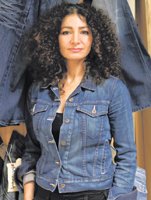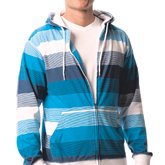Anchor Blue Charts New Direction
Tom Sands is making big denim promises.
“There’s nobody in the mall that will have the denim assortment that we do regardless of your fit,” said the chief executive officer of retail chain Anchor Blue.
The jeans and teens retailer emerged from bankruptcy last year, and the company plans to spend 2010 carving out a new niche and a new identity.
To do that, the company has brought in new executives to the design department. And it plans to expand its denim offerings to fit every teen—from the rail-thin boy with a size-28 waist to the curvy girl unable to find a selection of jeans at other retailers.
Anchor Blue plans to be the go-to place for jeans and denim-related clothes, said Sands, who has been the retailer’s CEO since 2007. He also hopes the retailer will be the destination for a budget-savvy demographic that ranges from young men’s and juniors up to college-age men and women. Nothing in the shop will be priced for more than $30.
The Corona, Calif.–based company backed up its goals with the hire of a new design director. Fashion turnaround artist Caroline Amrikhas was officially named design director in February.
The retailer also will turn itself into a vertical retailer where 90 percent of its merchandise will be designed and sourced for Anchor Blue, which has a fleet of 113 stores spread across the Western United States, including 74 in California.
Even with a new look, new focus and new executives, Anchor Blue has a tough road ahead to find success, said Jeffrey Van Sinderen, a retail analyst with financial-services company B. Riley & Co. “They’re trying to address the teen demographic. It is fiercely competitive. Everyone has denim. It has been a core category for teen retailers for several years,” Van Sinderen said. “It will come down to product. If they have strong product, they will get more mindshare.”Troubled past
Much of Anchor Blue’s pre-bankruptcy troubles were rooted in poor merchandising, Sands said. It had previously sourced more than 70 percent of Anchor Blue–branded merchandise from vendors who sold the similar inventory to median-priced department stores, such as JCPenney and the now-defunct Mervyns, which shuttered in 2008.
At the time, there was nothing to differentiate Anchor Blue’s merchandise from other teen retailers’—and, since then, the competition has become even sharper. Stores from Abercrombie & Fitch to the more value-oriented Forever 21 have increasingly racked up sales from people who once might have shopped at Anchor Blue.
There was more trouble for the company. It also was saddled with unprofitable stores in Florida and was charged with maintaining 73 Levi’s and Dockers outlet stores. Anchor Blue’s owners, private-equity firm Sun Capital Partners Inc., took a tough action to stop the retailer’s long line of bad breaks. In May of 2009, it filed for Chapter 11 bankruptcy for Anchor Blue.New direction, new team
Last August, Sun Capital Partners announced that the teen denim chain had emerged from bankruptcy. It sold the Levi’s and Dockers outlet stores for $72 million to Levi Strauss & Co. and closed more than 50 of its unprofitable stores. The company also changed its old name, Anchor Blue Retail Group, to its current name, Anchor Blue Inc. The bankruptcy and name change represented an opportune time to streamline the company and give it a new focus, Sands said.
For its merchandise, the company found new vendors that will offer more exclusive product, he said. With the hire of Amrikhas, Anchor Blue found a design director with a history of reinvigorating brands.
From 2006 to 2008, she worked as a design director for Levi Strauss & Co., where she focused on updating fits, fabrics and finishes in women’s and children’s jeans and packaging. For Anchor Blue, her team of 16 design and sourcing people is looking for ways to create a new look for the Anchor Blue brand.
The new look will have a streetwear style. There will be some inspirations of workwear in the upcoming Spring 2011 line. The brand’s jeans, hoodies and shirts will be made unique by some subtle details. “The next step is creating a brand,” she said. “The idea behind the brand is building iconic pieces that kids can mix and match and express their own identities by how they accessorize.” In addition, Anchor Blue will sell items from popular brands Dickies, Quiksilver, Roxy, Jolt and footwear brand Kobian.
Anchor Blue plans to attract new crowds of consumers with more stores and a sleeker footprint. The average square footage for an Anchor Blue store was 5,000 square feet. However, many of the stores are being remodeled to 3,500 square feet. By the end of 2010, the chain will open 10 stores. In 2011, it plans to open 10 to 15 more stores. In 2012, it will open 20 stores.
A new Anchor Blue store opened May 10 in Yuba City, Calif. In June, the company will open a new store in Hanford, located in California’s Central Valley. Later this year, an Anchor Blue boutique will open at the Village at Orange in Orange, Calif. The brand also will expand its chain of four outlet stores, including a store in the Los Angeles–area Citadel Outlet mall, set to open in October.Points of difference
Anchor Blue hopes to differentiate itself with its sales policies and its demographics. Instead of offering major promotions throughout the store, it will limit its promotions to a few tables that will offer something like $2.97 flip-flops.
Anchor Blue also aims to serve the growing Hispanic community, which Sands contends is underserved by national brands. A heavier marketing effort will go toward registering the Anchor Blue brand on the radar screens of new customers.
Marketing will be important to a more hip Anchor Blue. It recently launched Anchor Blue University, a program that will open pop-up shops on college campuses, military bases and sporting events with the latest in Anchor Blue fashions. It launched a Facebook page and also improved its Web site, where it produces contests and eventually will offer e-commerce.

























